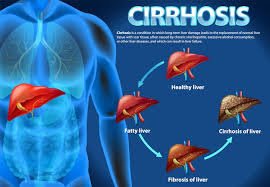Cirrhosis is a silent but deadly disease of the liver that often progresses quietly, without noticeable symptoms until it reaches advanced stages. It is a condition characterized by the scarring of the liver tissue, replacing healthy liver cells with fibrous scar tissue. This article explores the causes, progression, symptoms, and management of cirrhosis.
Causes
Cirrhosis is typically the result of long-term liver damage and can have multiple causes, including:
1. Alcohol Abuse: Chronic and excessive alcohol consumption can lead to alcoholic cirrhosis, one of the most common causes.
2. Viral Hepatitis: Hepatitis B and C infections can cause chronic liver inflammation, leading to cirrhosis if left untreated.
3. Non-Alcoholic Fatty Liver Disease (NAFLD): This condition is associated with obesity, diabetes, and metabolic syndrome. In some cases, it can progress to non-alcoholic steatohepatitis (NASH) and, eventually, cirrhosis.
4. Autoimmune Hepatitis: An autoimmune response where the body’s immune system mistakenly attacks healthy liver tissue.
5. Biliary Atresia: A rare condition present at birth, where bile ducts are absent or blocked, leading to cirrhosis in infants.
6. Hemochromatosis: A genetic disorder that causes the body to absorb and store too much iron, leading to liver damage.
Progression of Cirrhosis
Cirrhosis typically progresses through four stages:
1. Compensation: In this stage, the liver can still perform its vital functions despite some damage.
2. Decompensation: As cirrhosis worsens, the liver starts to lose its function. This stage is marked by the appearance of symptoms.
3. Portal Hypertension: Increased resistance to blood flow through the liver leads to high blood pressure in the portal vein, which can result in complications like varices (swollen veins), ascites (abdominal fluid buildup), and hepatic encephalopathy (brain dysfunction).
4. End-Stage Cirrhosis: At this point, the liver is severely damaged, and liver function is critically compromised. Liver transplantation is often the only treatment option.
Symptoms
Cirrhosis symptoms may not manifest until the disease reaches advanced stages. Some common signs include:
1. Fatigue: Feeling tired or weak is a common early symptom.
2. Jaundice: Yellowing of the skin and eyes due to the buildup of bilirubin in the blood.
3. Abdominal Pain: Discomfort or pain in the upper right side of the abdomen.
4. Swelling: Swelling in the legs, ankles, or abdomen due to fluid retention.
5. Itchy Skin: The accumulation of bile salts in the bloodstream can cause itching.
6. Nausea and Vomiting: Digestive problems may occur.
7. Unexplained Weight Loss: A loss of appetite and muscle mass is common.
8. Confusion and Memory Issues: Hepatic encephalopathy can lead to cognitive problems.
Diagnosis and Management
Diagnosing cirrhosis involves a combination of medical history, physical exams, and various tests. Blood tests measure liver function, while imaging studies such as ultrasound, CT scans, or MRI can visualize the liver’s condition. A liver biopsy may be performed to confirm the diagnosis.
Management of cirrhosis primarily focuses on preventing further liver damage and managing complications. Treatment may include:
1. Lifestyle Changes: Avoiding alcohol, maintaining a healthy diet, and exercising regularly.
2. Medications: Depending on the underlying cause, medications may help manage symptoms and slow the disease’s progression.
3. Liver Transplantation: For individuals with end-stage cirrhosis, a liver transplant may be necessary.
Challenges and Awareness
Cirrhosis is a significant global health concern, with millions of people affected worldwide. One of the challenges lies in early detection and intervention, as the disease often remains asymptomatic until severe damage has occurred. Raising awareness about the risk factors, the importance of regular check-ups, and understanding the symptoms is crucial for timely diagnosis and effective management.
Conclusion
Cirrhosis is a silent but serious liver disease that can have a substantial impact on one’s health and well-being. Understanding its causes, progression, symptoms, and management is essential for both patients and healthcare providers. With proper care and early intervention, it is possible to slow the progression of cirrhosis and improve the quality of life for affected individuals.

.jpeg)

